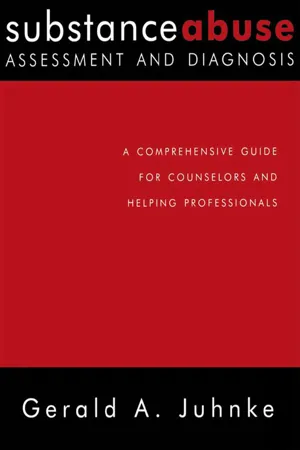
Substance Abuse Assessment and Diagnosis
A Comprehensive Guide for Counselors and Helping Professionals
- 240 pages
- English
- ePUB (mobile friendly)
- Available on iOS & Android
Substance Abuse Assessment and Diagnosis
A Comprehensive Guide for Counselors and Helping Professionals
About this book
Substance abuse counseling has gone beyond being viewed as optional training; instead it is fast becoming an essential part of the education of helping professionals. In this book, Dr. Gerald Juhnke presents an innovative, practical model to be used in the assessment and diagnosing of substance abuse and related co-morbid disorders.
Substance Abuse Assessment andDiagnosis includes practical "nuts and bolts" direction on how to facilitate a thorough, multi-tiered substance abuse assessment. This book uniquely incorporates detailed examples of how to use individual and significant other clinical interviews, including the CAGE, SUBSTANCE -Q, etc, standardized specialty instruments, drug detection types, and personality instruments to accomplish this feat. This is the only book of its kind that provides practical detail on how to use and score these varied assessment instruments-including the newest "cornerstone instruments," the MMPI-2, the SASSI-3 and the recently released SASSI-A2.
Students and practitioners alike will benefit from this comprehensive volume on the assessment and diagnosis of substance abuse.
Frequently asked questions
- Essential is ideal for learners and professionals who enjoy exploring a wide range of subjects. Access the Essential Library with 800,000+ trusted titles and best-sellers across business, personal growth, and the humanities. Includes unlimited reading time and Standard Read Aloud voice.
- Complete: Perfect for advanced learners and researchers needing full, unrestricted access. Unlock 1.4M+ books across hundreds of subjects, including academic and specialized titles. The Complete Plan also includes advanced features like Premium Read Aloud and Research Assistant.
Please note we cannot support devices running on iOS 13 and Android 7 or earlier. Learn more about using the app.
Information
Chapter 1
The Clinical Interviews, Standardized Speciality, Drug Detection, and Personality Assessment (CLISD-PA) Model Overview
Chapter 1 Outline:
- General CLISD-PA Overview
- CLISD-PA Assumptions
- Summary
Chapter 1 Learning Objectives:
- Provide a general description of the CLISD-PA model.
- Identify the purposes of each of the four tiers.
- Report the two basic CLISD-PA assumptions.
General CLISD-PA Overview
CLISD-PA Assumptions
| Individual Clinical Interview | |
| Sufficient information obtained to develop an accurate DSM–IV–TR diagnosis? | |
| Sufficient information obtained to develop a thorough and effective treatment plan? | |
| Yes: Proceed to significant other clinical interview | No: Identify needed information and continue individual clinical interview |
| Diagnose and provide therapeutic feedback to client | |
| Significant Other Clinical Interview | |
| Sufficient information obtained to develop an accurate DSM–IV–TR diagnosis? | |
| Sufficient information obtained to develop a thorough and effective treatment plan? | |
| Yes: Proceed to standard alcohol and other drug specialty/drug detection assessment individual clinical interview | No: Identify needed information and continue significant other clinical interview |
| Review diagnosis and provide therapeutic feedback to client | |
| Standardized Alcohol And Other Drug Specialty/Drug Detection Assessment | |
| Sufficient information obtained to develop an accurate DSM–IV–TR diagnosis? | |
| Sufficient information obtained to develop a thorough and effective treatment plan? | |
| Yes: Proceed to personality assessment | No: Identify needed information and continue standardized alcohol and other drug specialty/drug detection assessment |
| Review diagnosis and provide therapeutic feedback to client | |
| Personality Assessment | |
| Sufficient information obtained to develop an accurate DSM–IV–TR diagnosis? | |
| Sufficient information obtained to develop a thorough and effective treatment plan? | |
| Yes: Review diagnosis, coestablish treatment plan with client, and initiate treatment | No: Identify other information needed and conjointly determine with client how to obtain it |
Summary
Table of contents
- Cover
- Half Title
- Title
- Copyright
- Contents
- Preface
- Chapter 1 The Clinical Interviews, Standardized Speciality, Drug Detection, and Personality Assessment (CLISD-PA) Model Overview
- Chapter 2 The DSM-IV-TR Multiaxial System and Common Substance-Related Disorders
- Chapter 3 Tier One: Individual Clinical Interviews
- Chapter 4 Significant Other Interviews: Understanding and Promoting Change through Others
- Chapter 5 Standardized Alcohol and Other Drug (AOD) Speciality Assessment Instruments and Drug Detection Testing
- Chapter 6 Personality Assessment and Therapeutic Feedback
- Chapter 7 Conclusion
- Index